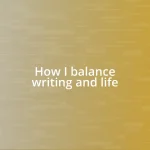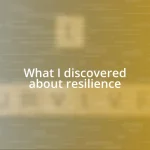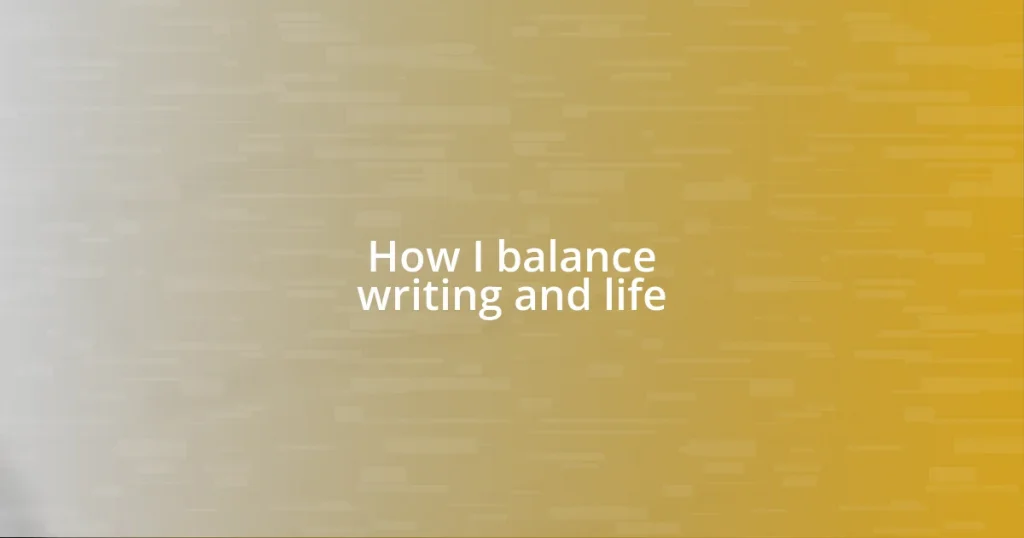Key takeaways:
- Clarity emerges from stillness and self-reflection, allowing for deeper understanding of personal values and goals.
- Recognizing signs of confusion, such as feeling overwhelmed or indecisive, is essential for seeking clarity and establishing a sense of direction.
- Practical techniques like journaling, meditation, and setting clear intentions are effective in achieving and maintaining mental clarity.

Understanding the concept of clarity
Clarity, at its core, means having a clear understanding of your thoughts and feelings. I remember a time when I felt overwhelmed by decisions—I constantly wavered, unsure of my own preferences. Have you ever felt that uncertainty creeping in, too? It can be disorienting, but gaining clarity transformed those murky waters into a clear stream of purpose for me.
One of the most profound lessons I learned about clarity is that it often arises from stillness. When I took the time to sit quietly with myself, away from distractions, the noise faded, revealing insights I hadn’t noticed before. Sometimes, I would ask myself simple questions: What truly matters to me? This practice of reflection opened a door to a deeper understanding of my values and goals, guiding my actions and decisions more consistently.
In essence, clarity is not merely a destination but a journey. I’ve found that maintaining clarity requires regular check-ins with myself. It’s an ongoing process, and there’s beauty in that. How often do you pause to assess your path? Those moments of introspection can illuminate the way forward, turning confusion into direction and empowering you to take control of your narrative.

Recognizing the need for clarity
Recognizing the need for clarity often starts with a feeling of discomfort or restlessness. I remember a particularly chaotic period in my life when every decision felt monumental, like standing at the edge of a cliff with no clear view below. It was during those moments of confusion that I realized something pivotal: clarity is necessary for peace of mind and effective decision-making. It’s a signal that something within needs tending.
- Signs that you might need clarity:
- Feeling overwhelmed by choices
- Constantly changing your mind
- A sense of discontent despite external success
- Difficulty articulating your goals or values
- Experiencing anxiety about the future
Identifying these signs was crucial for me. I began to prioritize moments of stillness in my routine, transforming my scattered thoughts into a clearer vision. These subtle shifts have a profound impact, guiding me back to a place of understanding and purpose when I stray into confusion.

Techniques to achieve mental clarity
When I realized that mental clarity was within my grasp, I turned to journaling as a technique. Writing down my thoughts helped untangle the confusion swirling in my mind. I found it was like clearing the clutter of a messy room; once everything is laid out on the page, the path to clarity becomes visible. Have you ever tried this? I highly recommend it for those who feel overwhelmed.
Meditation became another powerful tool in my quest for mental clarity. I remember the first time I silenced my racing thoughts—it felt foreign but gradually became a sanctuary for my mind. Just a few minutes of focused breathing eased the chaos, allowing me to view my thoughts without judgment. This simple act of stillness nurtured a sense of control that I hadn’t felt in ages.
Another technique I embraced was prioritizing my tasks using a clear to-do list. I’ve learned that when everything feels urgent, nothing gets done effectively. By jotting down what truly mattered each day, I could focus my energy on the most impactful activities. What a relief it was to witness increased productivity and diminished anxiety!
| Technique | Description |
|---|---|
| Journaling | A method to organize thoughts and gain insights by writing them down. |
| Meditation | A practice that calms the mind and helps observe thoughts without judgment. |
| Prioritizing Tasks | Utilizing to-do lists to focus on what truly matters for increased productivity. |

Setting clear intentions and goals
Setting clear intentions is like drawing a roadmap for your life; it creates a sense of direction. I still vividly recall the time I sat down, notebook in hand, and wrote out my intentions. It wasn’t just about what I wanted to achieve, but how I wanted to feel along the journey. Have you ever felt that your goals were just floating in the ether, lacking real substance? When I infused my ambitions with specific emotions and desires, everything started to click into place.
Goals without clarity can be like an incomplete jigsaw puzzle. I learned this when I set a vague goal to “be healthier” without really defining what that meant for me. After weeks of confusion, I finally decided to break it down—what specific changes would lead to this health improvement? I pinpointed that it meant cooking more at home, running three times a week, and even drinking more water. Once I set those clear intentions, I felt more focused and empowered to take actionable steps. It’s incredible how defining your goals nurtures a sense of ownership and motivation.
Moreover, revisiting those intentions is just as vital as setting them. In my experience, life often throws us off course, and I’ve found it helpful to review my goals regularly. I remember feeling lost during a busy work season, thinking, “Did I even remember why I started this?” By checking in with my intentions, I realigned my efforts and rekindled my passion. This practice of reflection, coupled with intention-setting, creates a continuous feedback loop that fosters meaningful clarity in my life. How often do you pause to assess your own intentions? It can be a game changer.

Overcoming obstacles to clarity
Sometimes, the biggest obstacles to clarity come from within ourselves. I recall a particularly tumultuous time when self-doubt crept in, clouding my decision-making abilities. I had to confront this inner critic head-on; acknowledging its presence was the first step. In doing so, I started to shift my perspective—rather than seeing self-doubt as an enemy, I began to view it as a teacher. It pushed me to question my motivations and seek deeper understanding. Have you ever had that nagging voice holding you back? Recognizing it can be liberating.
External distractions also formed a significant barrier in my journey towards clarity. There was a phase when I overloaded my schedule, thinking busyness equated to achievement. Each ping from my phone felt like a call to action, pulling me away from the important tasks at hand. I distinctly remember a week where I missed deadlines and felt defeated. That’s when I realized setting boundaries was essential. I started turning my phone on silent during focused work sessions and was surprised by how much mental space that created. Have you ever considered how social media impacts your focus? Finding that balance became a game changer for fostering clarity.
Finally, I learned that it’s okay to ask for help when the fog feels insurmountable. I found myself stuck in a decision-making loop, swirling in indecision. One day, I reached out to a trusted friend who offered a fresh perspective, asking me questions I hadn’t considered. Their insights illuminated a path I couldn’t see before. It’s a reminder that we don’t have to navigate our journeys alone. Have you ever thought about who you could turn to in times of uncertainty? Leaning on others can provide the clarity we often yearn for.

Practices for maintaining clarity
Maintaining clarity requires consistent practices that keep us aligned with our intentions. One simple but powerful method I adopted is daily journaling. In the mornings, I take a few minutes to jot down my thoughts, feelings, and priorities for the day. This habit often feels like decluttering my mind, making me aware of what truly matters. Have you ever noticed how much clarity can emerge just from putting pen to paper? For me, it’s like giving my brain a fresh start each morning.
Another practice that’s helped me tremendously is mindful meditation. I remember the first time I sat in silence, thoughts racing from one worry to another. But as I learned to focus on my breath, those distractions began to fade, revealing the clarity I craved. Have you ever felt like your mind is a whirlpool of thoughts and emotions? By simply observing those thoughts without judgment, I found a way to center myself. Integrating just ten minutes of meditation into my routine created a ripple effect in other areas of my life, helping me stay grounded and centered.
Lastly, I firmly believe in the power of ongoing self-checks. I often set aside time to review my progress—not just in terms of goals, but also how I’m feeling about them. Recently, I found myself overwhelmed by a project that had me second-guessing my choices. Taking a step back to assess what was draining my energy and whether it aligned with my values opened my eyes to adjustments I needed to make. Have you ever taken the time to reflect on whether your pursuits still resonate with you? These checks aren’t just about accountability; they are about nurturing and sustaining clarity through connection with one’s own evolving self.

Real life examples of clarity
I’ve experienced moments where clarity seemed just out of reach, particularly when I switched careers. I was overwhelmed with uncertainty about whether I was making the right choice. One afternoon, I decided to take a long walk in nature, letting my thoughts wander. As I listened to the rustling leaves and felt the sun on my face, everything started to click. It hit me that I needed to trust my instincts rather than relying on the opinions of others. Have you ever felt that a change was necessary but didn’t know where to begin? Sometimes, stepping away from the noise can bring a profound sense of clarity.
During a challenging project at work, I found myself stuck in analysis paralysis. I distinctly remember pacing my living room, wrestling with the details instead of taking action. Then, I made a simple but impactful shift: I focused on the smallest step forward rather than the overwhelming big picture. By breaking it down into manageable tasks, everything transformed. I was amazed at how clarity emerged from just taking one tiny action. Have you ever felt suffocated by an overwhelming task? It’s liberating to realize that clarity can come from simply starting.
A friend of mine recently shared an enlightening experience that resonated with me. After years of feeling unfulfilled in her job, she took a spontaneous trip alone. The experience forced her to confront her desires away from everyday distractions. Upon her return, she confidently pursued a new career path that echoed her passions. It was heartening to hear her speak about the clarity she gained; she now radiated enthusiasm. Have you ever done something spontaneous that changed your perspective? That sense of adventure can be a powerful catalyst for finding clarity.














